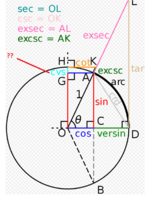You are using an out of date browser. It may not display this or other websites correctly.
You should upgrade or use an alternative browser.
You should upgrade or use an alternative browser.
CVS ??
- Thread starter markraz
- Start date
Harry_the_cat
Elite Member
- Joined
- Mar 16, 2016
- Messages
- 3,755
It is \(\displaystyle 1-sin\theta\). It stands for co-versin. Compare with the green versin.
D
Deleted member 4993
Guest
I did not know that and Google failed me.It is \(\displaystyle 1-sin\theta\). It stands for co-versin. Compare with the green versin.
Harry_the_cat
Elite Member
- Joined
- Mar 16, 2016
- Messages
- 3,755
To be honest, I've never heard of it before but I googled "versin"or versine.I did not know that and Google failed me.
Wikipedia: "The versine or versed sine is a trigonometric function already appearing in some of the earliest trigonometric tables. It is written as versin(θ), sinver(θ), vers(θ), ver(θ) or siv(θ)."
(I like to sound smarter than I am!)
Dr.Peterson
Elite Member
- Joined
- Nov 12, 2017
- Messages
- 16,605
I've heard of the versine, coversine, and also the haversine - mostly in math history. I haven't seen most of those abbreviations, and didn't know they were actively taught anywhere, though I'm familiar with something called the "haversine formula" for spherical distances. (Look it up.) You don't need to know about the haversine (half the versed sine) to use it.
D
Deleted member 4993
Guest
All the cats that I know do that - e.g. Garfield.....To be honest, I've never heard of it before but I googled "versin"or versine.
Wikipedia: "The versine or versed sine is a trigonometric function already appearing in some of the earliest trigonometric tables. It is written as versin(θ), sinver(θ), vers(θ), ver(θ) or siv(θ)."
(I like to sound smarter than I am!)
HallsofIvy
Elite Member
- Joined
- Jan 27, 2012
- Messages
- 7,763
Isn't CVS a drug store chain?
Dr.Peterson
Elite Member
- Joined
- Nov 12, 2017
- Messages
- 16,605
You were told that the coversine is defined as [MATH]1 - \cos(\theta)[/MATH]. That's easy enough to find on a calculator.
Perhaps you need to tell us what you are trying to calculate, given what values.
Perhaps you need to tell us what you are trying to calculate, given what values.
D
Deleted member 4993
Guest
Response #2 says:You were told that the coversine is defined as [MATH]1 - \cos(\theta)[/MATH]. That's easy enough to find on a calculator.
Perhaps you need to tell us what you are trying to calculate, given what values.
It is 1−sinθ. It stands for co-versin. Compare with the green versin.
Dr.Peterson
Elite Member
- Joined
- Nov 12, 2017
- Messages
- 16,605
Oops. I honestly thought I'd typed [MATH]1 - \sin(\theta)[/MATH]! But that "co" tends to slip into one's mind.

